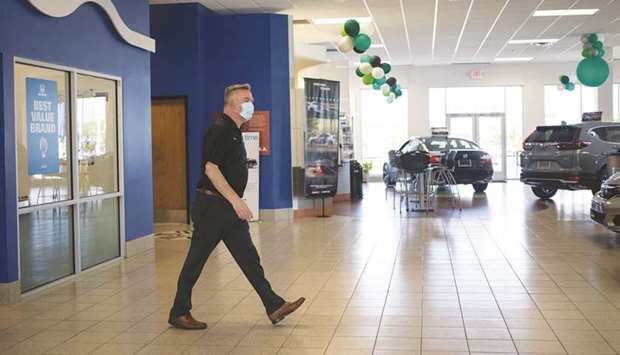US private employers stepped up hiring in September, but diminishing government financial assistance and a resurgence in new Covid-19 cases in some parts of the country could slow the labour market’s recovery from the pandemic.
Other data yesterday confirmed that the economy suffered its sharpest contraction in at least 73 years in the second quarter because of the disruptions from the coronavirus.
“The job market is getting better,” said Gus Faucher, chief economist at PNC Financial in Pittsburgh, Pennsylvania.
“But job growth will slow through the rest of 2020 and in 2021. The big gains from business re-openings are fading.”
Private payrolls increased by 749,000 jobs this month after rising 481,000 in August, the ADP National Employment Report showed.
Economists polled by Reuters had forecast private payrolls would rise by 650,000 in September.
Employment gains were spread across all industries and company size.
The ADP report is jointly developed with Moody’s Analytics.
Though it has fallen short of the government’s private payrolls count since May because of methodology differences, it is still watched for clues on the labour market’s health.
The ADP report is based on active and paid employees on company payrolls.
The Labour Department’s Bureau of labour Statistics (BLS) counts workers as employed if they received a paycheck during the week that includes the 12th of the month.
When businesses were shuttered in mid-March, millions of workers were either laid off or furloughed.
Economists say the return of furloughed workers when most businesses reopened in May boosted the payrolls numbers reported by the government.
New weekly applications for jobless aid have stalled at higher levels after dropping below 1mn in August as the government changed the way it strips seasonal fluctuations from the data.
Data from Homebase, a payroll scheduling and tracking company, showed fewer employees at work in September relative to August.
New daily Covid-19 cases started spiking last week for the first time in eight weeks.
Infections are expected to rise in the fall, which economists believe will lead to some restrictions being imposed on businesses in the services sector.
US stock indexes were trading higher.
The dollar rose against a basket of currencies. US Treasury prices fell. The government is scheduled to publish its closely followed employment report, which includes public workers, tomorrow.
According to a Reuters survey of economists, private payrolls probably increased by 850,000 jobs in September after rising 1.027mn in August.
With government employment expected to be held back by the departure of some temporary workers hired for the 2020 Census and coronavirus-related budget challenges at state and local governments, nonfarm payrolls are forecast advancing by 850,000 in September after increasing 1.371mn in August.
That would leave employment 10.7mn below its level in February.
Employment growth peaked in June when payrolls jumped by a record 4.781mn jobs.
Economists attribute the moderation in job gains to the lapse of programmes that helped businesses to pay wages, as well as an income subsidy for the unemployed.
In a separate report yesterday, the Commerce Department said gross domestic product plunged at a 31.4% annualised rate last quarter, the deepest drop in output since the government started keeping records in 1947.
That was revised up from the 31.7% pace reported last month and reflected a less sharp collapse in consumer spending than initially estimated.
After-tax profits without inventory valuation and capital consumption adjustment dropped at a revised rate of 10.5%. Profits were previously estimated to have declined at a 11.7% pace.
When measured from the income side, the economy contracted at a 33.5% rate in the second quarter.
Gross domestic income (GDI) was previously reported to have declined at a 33.1% pace.
The average of GDP and GDI, also referred to as gross domestic output and considered a better measure of economic activity, decreased at a 32.5% rate last quarter.
That was revised from the 32.4% rate estimated last month.

An employee wears a protective mask while working at a Honda Motor Co dealership in Southfield, Michigan. Private payrolls increased by 749,000 jobs this month after rising 481,000 in August, the ADP National Employment Report showed.


